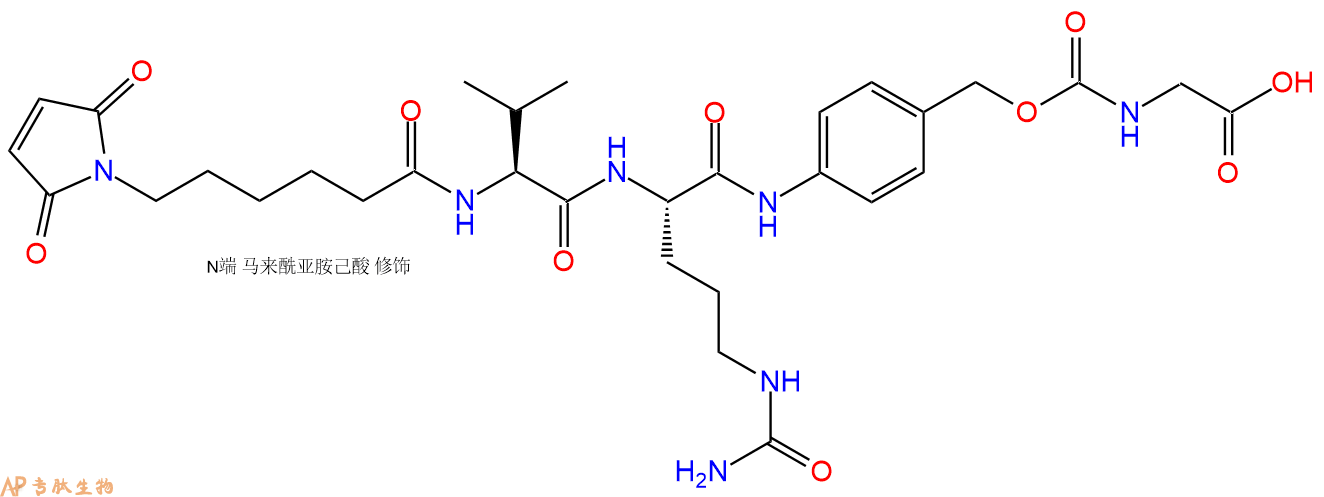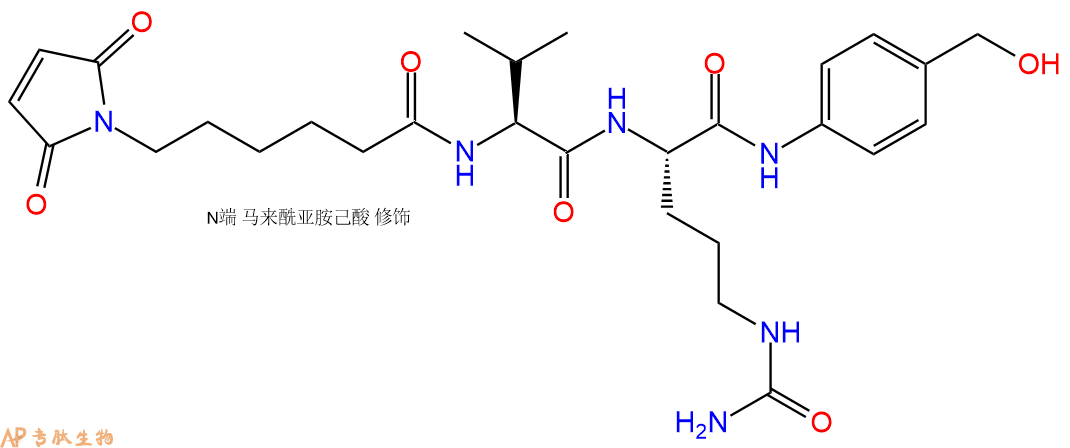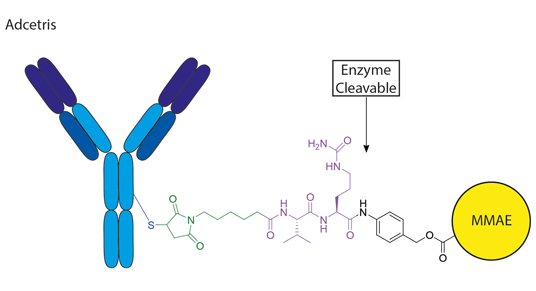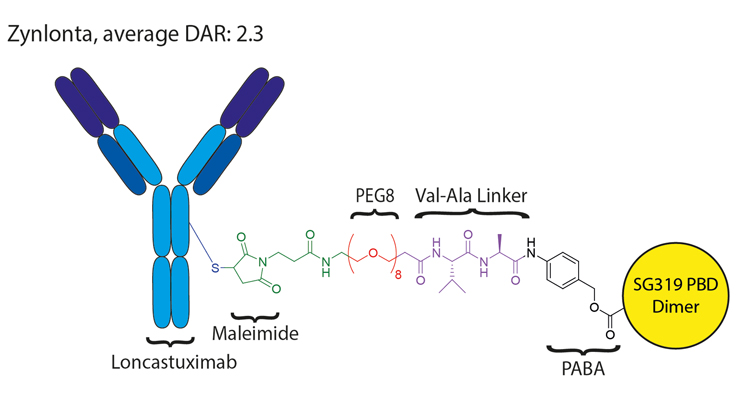
MC-Val-Cit-PAB-Gly是一种可裂解的ADC接头,其特征是连接到甘氨酸残基的马来酰亚胺、缬氨酸-瓜氨酸(Val-Cit)二肽和对氨基苄基(PAB)间隔区。马来酰亚胺是一种硫醇特异性共价连接体,用于标记蛋白质中的半胱氨酸残基,而甘氨酸的特征是羧酸可以自由地与胺连接形成酰胺键。蛋白酶切割二肽触发PAB通过消除机制有效释放药物有效载荷。
编号:436740
CAS号:
单字母:6Mal-V-Cit-PAB2-G-OH
| 编号: | 436740 |
| 中文名称: | MC-Val-Cit-PAB-Gly |
| 英文名: | MC-Val-Cit-PAB-Gly |
| 单字母: | 6Mal-V-Cit-PAB2-G-OH |
| 三字母: | 6Mal 马来酰亚胺己酸修饰 -Val缬氨酸 -Cit瓜氨酸 -PAB2暂无说明 -Gly甘氨酸 -OHC端羧基 |
| 氨基酸个数: | 4 |
| 分子式: | C31H43N7O10 |
| 平均分子量: | 673.71 |
| 精确分子量: | 673.31 |
| 等电点(PI): | - |
| pH=7.0时的净电荷数: | - |
| 平均亲水性: | -1.5 |
| 疏水性值: | 1.9 |
| 消光系数: | - |
| 标签: | 马来酰亚胺基修饰肽 氨基酸衍生物肽 Peptide linkers (ADC Linkers) |
MC-Val-Cit-PAB-Gly是一种可裂解的ADC接头,其特征是连接到甘氨酸残基的马来酰亚胺、缬氨酸-瓜氨酸(Val-Cit)二肽和对氨基苄基(PAB)间隔区。马来酰亚胺是一种硫醇特异性共价连接体,用于标记蛋白质中的半胱氨酸残基,而甘氨酸的特征是羧酸可以自由地与胺连接形成酰胺键。蛋白酶切割二肽触发PAB通过消除机制有效释放药物有效载荷。
MC-Val-Cit-PAB-Gly is a cleavable ADC linker featuring a maleimide, a valine-citrulline (Val-Cit) dipeptide, and a para-aminobenzyl (PAB) spacer ligated to a glycine residue. Maleimide is a thiol-specific covalent linker which is used to label cysteine residues in proteins while the glycine features a carboxylic acid which is free to link with amines to form amide bonds. Dipeptide cleavage by proteases triggers the PAB to efficiently release the drug payload via an elimination mechanism.
马来酰亚胺基修饰-说明
马来酰亚胺基修饰在多肽的设计中,经常用到。通常在多肽的一端修饰马来酰亚胺基,然后通过马来酰亚胺基和材料上的巯基结合,从而将多肽固定到材料上。专肽生物可以定制合成多肽的马来酰亚胺基修饰。
通常,马来酰亚胺基分为2种,
一种是3-Mal (3-马来酰亚胺基丙酸),例如下图

另一种是6-Mal(6-马来酰亚胺基己酸)。例如下图

ADC linkers的介绍
ADC linkers are one of the three main components of the antibody drug conjugates (ADC) that connect an antibody with a potent drug (payload) through a chemical bond.
Role of ADC Linkers
ADC linkers play key roles in determining the overall success of the Antibody Drug Conjugates. One of the main challenges in developing a safe and effective ADC drug (Figure 1) is the assembly of a desirable chemical linker between cytotoxic payload and mAb. A well-designed ADC linker can help the antibody to selectively deliver and accurately release the cytotoxic drug at tumor sites. It also plays critical roles in an ADCs' stability during preparation, storage, and systemic circulation. A stable ADC drug ensures that less cytotoxic payloads fall off before reaching tumor cells, increasing safety, and limiting dose.
There are two main categories of ADC linkers in current ADC drugs, cleavable linkers and non-cleavable linkers.

Figure 1. There are three major components of an ADC drug; the antibody used, the linker, and the payload to be delivered.
Cleavable linkers are designed to be stable in the bloodstream and then release the payload once in the cell. Cleavable linker types include enzymatically-cleavable peptide linkers, acid sensitive hydrazone linkers, and glutathione-sensitive disulfide linkers.
Example of Cleavable Linkers in ADC

Figure 2. Adcetris with enzymatically cleavable val-cit linkage.
The non-cleavable linkers, such as SMCC, rely on lysosomal degradation within the cell to release the drug payload.
A summary of linker types is provided in Table 1.
Table 1. Linker type, mechanism and advantages of cleavable and non-cleavable linkers.
| Linker | Strategy | Mechanism | Advantages |
| Cleavable Linker | Peptides | Selectively cleaved by hydrolytic enzymes | Stability during circulation Hydrophilicity Traceless release of payload |
| Hydrazone | Acid-sensitive environments endosomal (pH = 5-6) lysosomal (pH = 4.8) | Intracellular release of payload | |
| Disulfide | Intracellular reducing molecules, such as glutathione | Intracellular release of payload | |
| Non-cleavable Linker | Stable linker without cleavage mechanism | Unknown mechanism of lysosomal cleavage | Stability during circulation |
An interesting part of the ongoing discussion about linker stability is whether the payload can or should be released into the area outside of the tumor cell. This effect, referred to as the ‘bystander effect’, is seen by some as a beneficial attribute for an ADC to display. However, recent studies indicate that, depending on the linker and payload combination, this mechanism may not be essential, and ADCs can be cleaved extracellularly or via other mechanisms.
PEG Increases the Solubility of ADC Linkers
The solubility of the linker is another parameter that has been explored using Monodispered PEG chains. Two of the latest ADCs to be approved, Trodelvy and Zynlonta, were developed with PEG moiety as part of their linker technology to improve solubility and stability in vivo.
Example of ADC Linkers with PEG Chain

Figure 3. Zynlonta, shown above, has several unique features including a maleimide group for attachment to the mAbs, a PEG8 linker for solubility, and a cleavable Val-Ala section bound to the drug SG3199.
Journal Reference:
Halford, "A new generation of antibody-drug conjugates for cancer patients", Chemical and Engineering News, vol 98, 14, (2020) https://cen.acs.org/biological-chemistry/cancer/new-generation-antibody-drug-conjugates/98/i14
Staudacher, Brown, "Antibody drug conjugates and bystander killing: is antigen-dependent internalisation required?", Br J Cancer 117, (2017): 1736–1742, https://www.nature.com/articles/bjc2017367#citeas
Joubert, et al., "Antibody-Drug Conjugates: The Last Decade", Pharmaceuticals (Basel, Switzerland) vol 13,9, (2020): 245-276, https://pubmed.ncbi.nlm.nih.gov/32937862/





